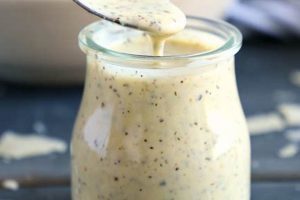A vibrant and flavorful complement to the often-bland broccoli floret, a well-crafted sauce can transform this cruciferous vegetable into a culinary delight. Typically, such a sauce blends creamy, sweet, and tangy elements, often incorporating mayonnaise, vinegar, and sweeteners. Dried fruits like cranberries or raisins, along with nuts and seeds, contribute textural complexity and complementary flavors. Bacon or red onion can add savory notes. Variations can include a buttermilk base, Dijon mustard, or different types of vinegar to create unique flavor profiles.
Elevating simple broccoli from a side dish to a star, a complementary sauce adds depth and excitement. Historically, creamy salads gained popularity in the mid-20th century, and broccoli salad emerged as a healthy and flavorful option. This dish offers a versatile platform for culinary creativity, allowing for adjustments to sweetness, tanginess, and added ingredients to cater to individual preferences. The inherent nutritional value of broccoli, combined with the flavor-enhancing properties of the sauce, makes this dish a popular choice for potlucks, picnics, and everyday meals.
This exploration will delve into various approaches to creating the ideal complement to broccoli, discussing specific ingredient choices, preparation techniques, and variations that cater to different dietary needs and taste preferences. From classic combinations to innovative twists, the following sections will provide a comprehensive guide to crafting a delicious and memorable broccoli salad experience.
Tips for Crafting the Perfect Broccoli Salad Dressing
Achieving a harmonious balance of flavors and textures is crucial for a successful broccoli salad. These tips offer guidance for creating a dressing that complements the broccoli while adding depth and complexity.
Tip 1: Balance Sweet and Tangy Elements: The interplay of sweetness and acidity is fundamental. A ratio skewed too heavily towards either extreme can result in a less satisfying outcome. Consider using a combination of sugar and vinegar, adjusting proportions to achieve the desired balance. Lemon juice can offer a brighter alternative to vinegar.
Tip 2: Embrace Textural Variety: Incorporating ingredients like toasted nuts, dried fruits, and seeds introduces textural contrasts that enhance the overall experience. Chopped red onion or crumbled bacon adds further complexity.
Tip 3: Choose the Right Fat: Mayonnaise provides a classic creamy base. However, Greek yogurt or a combination of mayonnaise and yogurt offers a lighter, tangier alternative. Consider the impact of the chosen fat on the final flavor profile.
Tip 4: Enhance with Flavorful Additions: Dijon mustard, minced garlic, or a pinch of red pepper flakes can elevate the dressing’s complexity. Experiment with different herbs and spices to create unique flavor combinations.
Tip 5: Blanch the Broccoli: Briefly blanching the broccoli florets ensures a vibrant green color and a tender-crisp texture. This step also helps the broccoli absorb the dressing more effectively.
Tip 6: Chill Before Serving: Allowing the salad to chill in the refrigerator for at least 30 minutes, and preferably longer, allows the flavors to meld and the broccoli to marinate thoroughly.
Tip 7: Taste and Adjust: Before serving, taste the salad and adjust seasonings as needed. This final step ensures the perfect balance of flavors tailored to individual preferences.
By following these guidelines, one can create a broccoli salad dressing that elevates this simple vegetable to a culinary masterpiece. The combination of fresh ingredients, balanced flavors, and textural variety contributes to a truly satisfying and memorable dining experience.
The following section will offer specific recipe examples incorporating these tips, demonstrating the versatility and potential of broccoli salad.
1. Creamy Base
The creamy base forms the foundation of most broccoli salad dressings, providing a rich, cohesive texture that binds the ingredients and coats the broccoli florets. This element contributes significantly to the overall sensory experience, offering a smooth counterpoint to the crisp-tender broccoli. The creaminess also helps to distribute and carry the other flavors within the dressing, ensuring a balanced and harmonious profile. Mayonnaise is the most common choice, offering a classic flavor and readily available convenience. However, alternatives like Greek yogurt, sour cream, or even avocado-based dressings offer lighter and tangier options, catering to varying dietary preferences and flavor profiles. The choice of creamy base significantly impacts the final taste and texture of the salad.
The selection of a creamy base influences not only the flavor and texture but also the nutritional value and overall richness of the salad. For instance, using Greek yogurt instead of mayonnaise reduces fat content while increasing protein. A blend of mayonnaise and Greek yogurt can offer a compromise, retaining some richness while lightening the overall profile. Avocado-based dressings provide healthy fats and a distinct flavor. Understanding these nuances allows for informed choices based on dietary considerations and desired taste outcomes. Furthermore, the creamy base interacts with other dressing components. A tangier base might necessitate adjustments to the sweetness or acidity of other ingredients to achieve a balanced flavor profile. For example, a Greek yogurt base might require slightly less vinegar than a mayonnaise base due to its inherent tanginess.
Careful consideration of the creamy base is essential for a well-executed broccoli salad. It provides the textural foundation, influences flavor interactions, and impacts nutritional value. Whether opting for the classic richness of mayonnaise, the tangy lightness of Greek yogurt, or the healthy fats of an avocado-based dressing, the creamy base serves as a critical component, impacting the overall success of the dish. Selecting the appropriate base and understanding its interaction with other ingredients ensures a harmonious balance of flavors and textures, contributing to a truly satisfying culinary experience.
2. Sweetener Balance
Sweetener balance plays a crucial role in a successful broccoli salad dressing. It tempers the potentially sharp flavors of other components, like vinegar or certain spices, creating a more harmonious and palatable profile. This balance prevents the dressing from becoming overly tart or cloyingly sweet, allowing the natural flavors of the broccoli and other ingredients to shine through. The type and amount of sweetener influence the overall character of the salad. Granulated sugar provides a clean sweetness, while honey adds subtle floral notes and a thicker consistency. Maple syrup offers a distinct caramel-like flavor. The choice depends on the desired flavor profile and the other ingredients in the dressing. For example, a dressing with apple cider vinegar and dried cranberries might benefit from the complementary sweetness of honey or maple syrup, while a simpler vinegar-based dressing might call for granulated sugar.
Achieving the right sweetener balance requires careful consideration of the other dressing components. A highly acidic vinegar, for instance, will require more sweetener than a milder one. The presence of other sweet elements, such as dried fruit, also influences the amount of added sweetener needed. Over-sweetening can mask the subtle flavors of the broccoli and other ingredients, while insufficient sweetness can result in a harsh, unbalanced dressing. Practical experimentation and taste-testing are often necessary to fine-tune the balance and achieve the desired result. Consider starting with a smaller amount of sweetener than a recipe suggests and gradually adding more until the desired level of sweetness is reached. This method allows for greater control and prevents over-sweetening.
In conclusion, sweetener balance acts as a critical bridge, uniting the diverse flavors within a broccoli salad dressing. It harmonizes contrasting elements, enhances the overall palatability, and allows the individual flavors of the ingredients to shine. Careful consideration of sweetener type, quantity, and its interaction with other dressing components are essential for creating a truly balanced and delicious broccoli salad. Mastering this element elevates the dish beyond a simple side to a more complex and satisfying culinary experience.
3. Tangy Accent
The tangy accent in a broccoli salad dressing provides a crucial counterpoint to the creamy base and sweetness, creating a dynamic flavor profile that prevents the salad from feeling heavy or overly rich. This element introduces brightness and complexity, cutting through the richness of the mayonnaise and balancing the sweetness of added sugars or dried fruits. The tangy element is essential for a well-rounded and refreshing salad experience.
- Vinegar Variety
Vinegar serves as the primary source of tang in most broccoli salad dressings. Different varieties offer unique flavor nuances. Apple cider vinegar contributes a mild, fruity acidity, while white wine vinegar provides a sharper, cleaner bite. Red wine vinegar offers a more robust, complex tang. The choice of vinegar significantly influences the overall flavor profile of the dressing. For example, a sweeter dressing might pair well with the mellow acidity of apple cider vinegar, while a dressing with bolder flavors might benefit from the sharpness of white wine vinegar.
- Citrus Alternatives
Citrus juices, such as lemon or lime juice, offer a brighter, more vibrant tanginess compared to vinegar. These alternatives can create a lighter, more refreshing dressing, particularly suitable for summer salads. Lemon juice pairs well with herbs like dill and parsley, while lime juice complements flavors like cilantro and ginger. Using citrus juice introduces a distinct character to the salad, differentiating it from traditional vinegar-based versions.
- Balancing Act
The level of tanginess should be carefully balanced against the other flavors in the dressing. Too much acidity can overpower the other ingredients, while too little can result in a bland or one-dimensional salad. The balance depends on the desired flavor profile and the specific ingredients used. A dressing with strong cheeses or savory additions might require a more pronounced tang, while a salad with delicate flavors might benefit from a subtler acidity.
- Flavor Enhancement
The tangy element not only provides balance but also enhances the other flavors in the dressing. It brightens the sweetness of dried fruits, accentuates the savory notes of nuts or seeds, and complements the creamy base. This interplay of flavors creates a more dynamic and complex taste experience, elevating the salad beyond a simple combination of ingredients.
The tangy accent acts as a critical component in a broccoli salad dressing, contributing brightness, balance, and flavor enhancement. The careful selection and balancing of this element, whether through vinegar or citrus juice, elevates the salad from simple to sophisticated, ensuring a refreshing and flavorful culinary experience. The interplay of creamy, sweet, and tangy elements creates a dynamic and harmonious dressing that complements the broccoli perfectly.
4. Textural Additions
Textural additions represent a critical component within a broccoli salad dressing, elevating the dish beyond a simple combination of flavors. These additions introduce contrasting elements that interact with the creamy, sweet, and tangy components of the dressing, creating a more complex and engaging sensory experience. The interplay of textures provides a dynamic element that enhances enjoyment and adds depth to each bite. Consider the contrast between the smooth creaminess of mayonnaise, the crisp-tender broccoli florets, and the crunchy additions of toasted nuts or seeds. This contrast stimulates the palate and adds interest to the overall consumption experience. Common textural additions include nuts like almonds, walnuts, or pecans; seeds like sunflower or pumpkin seeds; and dried fruits such as cranberries, raisins, or chopped apricots. Each offers a unique textural profile and contributes to the overall balance of the salad.
The strategic inclusion of textural elements serves several important functions within the broccoli salad. Beyond enhancing the sensory experience, these additions can contribute to nutritional value and offer complementary flavors. Nuts and seeds, for example, introduce healthy fats, protein, and fiber, while dried fruits contribute natural sweetness and a chewy texture. Furthermore, these components can absorb and carry flavors from the dressing, creating pockets of concentrated taste that burst upon biting. For example, toasted nuts can absorb the tanginess of the vinegar and the sweetness of the dressing, creating a complex and layered flavor profile. The variety and quantity of textural additions can be adjusted to suit individual preferences and dietary needs, offering a flexible approach to customizing the salad. A salad intended as a light side dish might benefit from a smaller quantity of nuts and seeds, while a more substantial salad can accommodate a greater volume of textural elements.
In conclusion, the incorporation of textural additions represents a crucial step in crafting a truly exceptional broccoli salad. These elements contribute not only to the sensory experience but also to the nutritional value and overall flavor profile of the dish. Careful selection and balanced incorporation of these additions elevates the salad, transforming it into a more complex and satisfying culinary creation. Understanding the interplay of textures and flavors allows for a more nuanced approach to creating a broccoli salad that delights the palate and provides a truly memorable dining experience.
5. Flavorful Enhancements
Flavorful enhancements represent the final, crucial layer of complexity in a broccoli salad dressing, elevating it from palatable to exceptional. These additions, while often subtle, contribute significantly to the overall depth and balance of the flavor profile, transforming a simple dressing into a culinary statement. They interact synergistically with the creamy base, sweetness, tangy notes, and textural elements, creating a harmonious blend that enhances the natural flavors of the broccoli and other ingredients.
- Herbs and Spices
Fresh or dried herbs and spices contribute depth and complexity. Dill, parsley, and chives offer bright, herbaceous notes, while a pinch of red pepper flakes adds a subtle heat. Garlic powder or onion powder provides savory depth. The choice of herbs and spices should complement the other flavors in the dressing and enhance the overall character of the salad. For instance, dill pairs well with a lemon-based dressing, while chives complement a sweeter, creamier profile.
- Savory Additions
Incorporating savory elements like crumbled bacon, shredded cheese, or chopped red onion adds a contrasting dimension to the sweetness and tanginess of the dressing. These additions provide a salty, umami counterpoint, creating a more balanced and nuanced flavor profile. The quantity and type of savory additions should be carefully considered to avoid overpowering the other flavors in the salad.
- Flavorful Oils
The choice of oil in the dressing, even in small quantities, can subtly influence the overall flavor profile. A high-quality extra virgin olive oil adds a fruity, peppery note, while a toasted sesame oil contributes a nutty aroma. These nuances, while subtle, can significantly enhance the complexity of the dressing.
- Seasoning Adjustments
Salt and black pepper are fundamental seasonings that should be adjusted to taste throughout the dressing preparation process. Proper seasoning enhances the other flavors, creating a more balanced and palatable final product. A touch of sea salt can brighten the flavors, while freshly ground black pepper adds a subtle warmth and complexity.
Flavorful enhancements represent the finishing touch that transforms a broccoli salad dressing from ordinary to extraordinary. These carefully chosen additions, ranging from herbs and spices to savory elements and nuanced oils, interact with the other components of the dressing, creating a complex and balanced symphony of flavors. The strategic use of these enhancements elevates the salad, offering a more sophisticated and satisfying culinary experience. A well-crafted broccoli salad, incorporating these subtle yet impactful flavor additions, exemplifies the potential of simple ingredients to create a truly remarkable dish.
Frequently Asked Questions
This section addresses common inquiries regarding the preparation and enjoyment of broccoli salad, offering practical guidance for achieving optimal results.
Question 1: How can one prevent broccoli salad from becoming watery?
Excess moisture can result from insufficiently dried broccoli florets or over-marinating. Thoroughly drying the broccoli after blanching and adding the dressing shortly before serving minimizes water accumulation. Salting the cut broccoli and allowing it to sit in a colander for 30 minutes before rinsing and drying also helps draw out excess moisture.
Question 2: What are suitable alternatives to mayonnaise in the dressing?
Greek yogurt provides a lighter, tangier alternative to mayonnaise, reducing overall fat content. A combination of mayonnaise and Greek yogurt offers a compromise, retaining some creaminess while increasing protein. Avocado can be blended into a creamy base for a vegan and healthy fat option. Plain yogurt or sour cream can also be substituted, though flavor adjustments may be necessary.
Question 3: How long can broccoli salad be stored?
Properly stored in an airtight container in the refrigerator, broccoli salad typically maintains optimal quality for three to five days. However, the texture of the broccoli may soften over time. Freezing is not recommended, as it significantly alters the texture of the broccoli and the consistency of the dressing.
Question 4: Can the dressing be made in advance?
The dressing components, excluding the broccoli, can be prepared a day or two in advance and stored separately in an airtight container in the refrigerator. This allows the flavors to meld. Combining the dressing and broccoli shortly before serving maintains the vegetable’s crisp-tender texture.
Question 5: How can one adjust the sweetness and tanginess of the dressing?
Taste and adjust the dressing incrementally. Add small amounts of sugar or honey to increase sweetness and vinegar or lemon juice for additional tang. Achieving the desired balance depends on individual preference and the specific ingredients used. Tasting throughout the process ensures a well-balanced final product.
Question 6: What are some variations for added ingredients in the salad?
Beyond the classic additions of dried cranberries, raisins, sunflower seeds, and red onion, consider incorporating other ingredients like chopped apples, grapes, or dried cherries for sweetness and varied textures. Roasted chickpeas or edamame can add protein, while toasted slivered almonds or chopped walnuts provide healthy fats and crunch. Crumbled bacon or diced ham introduce savory notes. Experimentation with different ingredients allows for customization and variety.
Understanding these common points of inquiry allows for a more informed approach to creating and enjoying broccoli salad. Addressing these considerations ensures optimal results, leading to a more satisfying culinary experience.
The following section will offer a collection of curated recipes, providing practical examples for creating diverse and flavorful broccoli salads.
Conclusion
Exploration of broccoli salad dressing formulation reveals the critical interplay of creamy, sweet, and tangy elements. Achieving a harmonious balance among these components, complemented by strategically chosen textural additions and nuanced flavor enhancements, elevates this seemingly simple dish to a culinary experience. Understanding the function of each ingredient, from the creamy base to subtle seasonings, empowers culinary experimentation and personalized adaptations. Emphasis on freshness, quality ingredients, and thoughtful preparation techniques contributes significantly to the overall enjoyment and success of broccoli salad.
The potential for variation within the framework of a broccoli salad dressing recipe offers a canvas for culinary creativity. Exploration of diverse flavor profiles and textural combinations ensures continued enjoyment and discovery within this versatile culinary landscape. Careful consideration of individual preferences and dietary needs allows for personalized adaptations, guaranteeing a satisfying and memorable experience for all. Continued experimentation promises exciting new interpretations of this classic dish.





